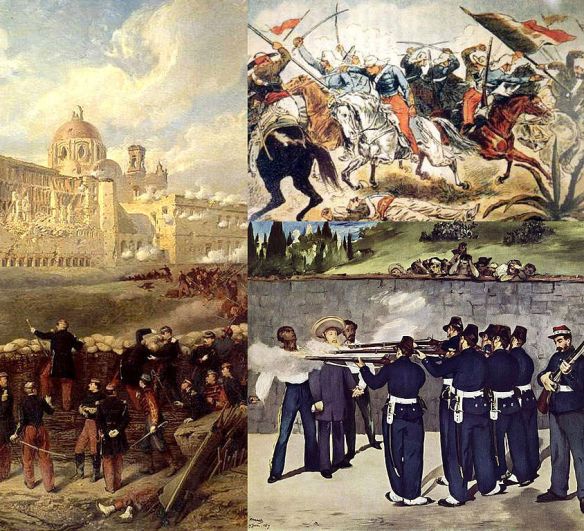Clockwise from left: (1) French assault on the fort of San Xavier during the siege of Puebla (March 1863) (2) French cavalry capture the Republican’s flag during the Battle San Pablo del Monte (1863) (3) Manet’s depiction of the execution of Emperor Maximilian (1867)
PRINCIPAL COMBATANTS: France and Mexican conservative forces vs. forces loyal to Mexican president Juarez; U. S. forces were available, but never engaged
PRINCIPAL THEATER(S): Mexico
MAJOR ISSUES AND OBJECTIVES: France deposed President Benito Juarez and installed and supported Austrian archduke Maximilian as emperor.
OUTCOME: After France withdrew its support for Maximilian, he was deposed and executed, and Juarez was reinstated as president.
APPROXIMATE MAXIMUM NUMBER OF MEN UNDER ARMS: French forces, 40,000, augmented by Mexican conservative forces; Liberal forces, 20,000 at any one time; U. S. forces (never engaged) 50,000
CASUALTIES: France, 6,654 killed; Mexican conservatives, 5,671 killed, 2,159 wounded, 4,379 prisoners; Juarez’s forces, 31,962 killed (including 11,000 executed), 8,304 wounded, 33,281 prisoners
When President Benito Juarez (1806-72) sought to bring economic relief to impoverished Mexico by declaring a moratorium on the payment of foreign debts, he opened the door to European imperialism, providing an excuse for Britain, France, and Spain to send a military force to Mexico, ostensibly to compel the payment of the debt. The joint army landed at Veracruz on December 17, 1861, and advanced to Orizaba. Acting in good faith, however, the British and Spanish contingents withdrew after Juarez persuaded diplomats that the debts would be paid in good time. Emperor Napoleon III (1808-73) of France, however, seized the opportunity to effectively render Mexico a puppet with the intention of creating a new French empire in the New World.
Napoleon III sent an army of 7,500 men under General Charles Ferdinand Latrille de Lorencez (1814-92) against Mexico City, which was defeated at the Battle of Puebla on May 5, 1862, by 12,000 men under General Ignacio Zaragoza (1829-62). (The victory is celebrated today as the Mexican national holiday of Cinco de Mayo.) French casualties were in excess of 400, whereas the Mexicans lost 215 killed and wounded.
After Puebla, Lorencez was relieved and replaced by General Élie Forey (1804-72), who arrived in September 1862 with an additional 30,000 troops. On February 17, 1863, the greatly enlarged French army, augmented by Mexican conservative forces, advanced from Orizaba for a new assault on Puebla, which was defended by a much smaller garrison under General Jesus Gonzales Ortega (1824-81). Under continual guerrilla attack, the French were not able to begin the assault on Puebla until May 4. On May 8, Ignacio Comonfort (1812-63) led a Mexican column to the relief of Puebla, but was ambushed and routed by a French force under General Achille Bazaine (1811-88). Comonfort died in this battle. The situation now hopeless for the Puebla defenders, Ortega surrendered on May 17.
The French army now advanced to Mexico City, marching into the capital on June 7. President Juarez fled the capital and set up a headquarters and government in exile near the Texas border. On June 12, 1863, Archduke Maximilian (1832-67) of Austria was enthroned at the behest of Napoleon III as emperor of Mexico. Although the French emperor intended that Maximilian would govern as his puppet, the new emperor took his office seriously and was determined to govern as his own man and for the benefit of the Mexican people. This notwithstanding, the liberal majority of the Mexican people were opposed to the foreign ruler in their midst, and a guerrilla war commenced.
Throughout the war in Mexico, the ongoing UNITED STATES CIVIL WAR prevented that country’s involvement. When the war ended in 1865, however, President Andrew Johnson invoked the Monroe Doctrine, by which the United States had proclaimed its standing position that any act of European aggression against a nation in the Americas would be regarded as an act against the United States itself. General Philip Sheridan (1831-88) was dispatched with 50,000 troops to the Rio Grande, the border with Mexico. A diplomatic standoff developed and, at last, on February 5, 1867, Napoleon III withdrew his troops and support from Maximilian- who, in any case, had proved a disappointment in his failure to bend entirely to the French emperor’s will.
With the French forces gone, Maximilian was supported only by conservative Mexicans, but stubbornly refused to abdicate. Juarez dispatched liberal forces under Mariano Escobedo (1827-1902) to attack Maximilian and his forces at Querétaro, which was besieged for 71 days. On May 14, Maximilian was betrayed by one of his own men into surrender. Despite protests and appeals from the international community, he was court-martialed, sentenced to death, and executed on June 19, 1867. With that, the war ended.
Further reading: Michelle Cunningham, Mexico and the Foreign Policy of Napoleon III (London: Palgrave, 2001); Enrique Krause, Mexico: Biography of Power, A History of Modern Mexico, 1810-1996 (New York: Harper- Collins, 1998); Ernst Pittner, Maximilian’s Lieutenant: A Personal History of the Mexican Campaign (Albuquerque: University of New Mexico Press, 1993); Walter V. Scholes, Mexican Politics during the Juarez Regime, 1855-1872 (Columbia: University of Missouri Press, 1969).
